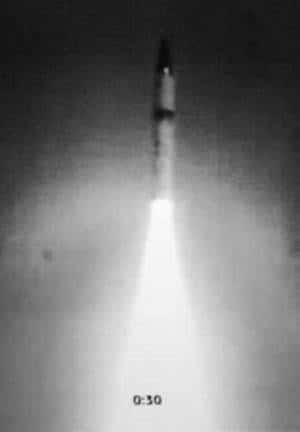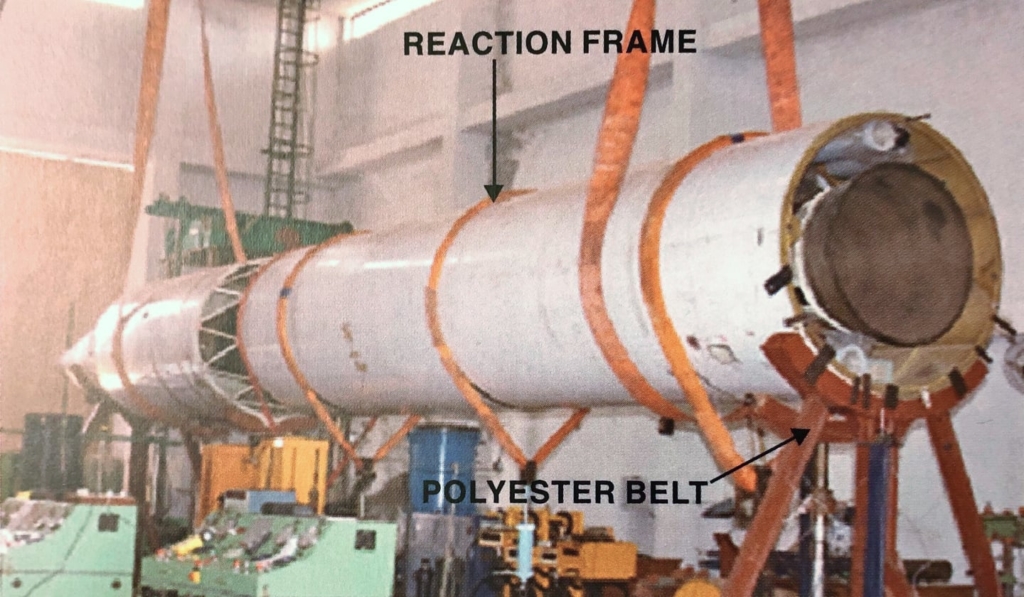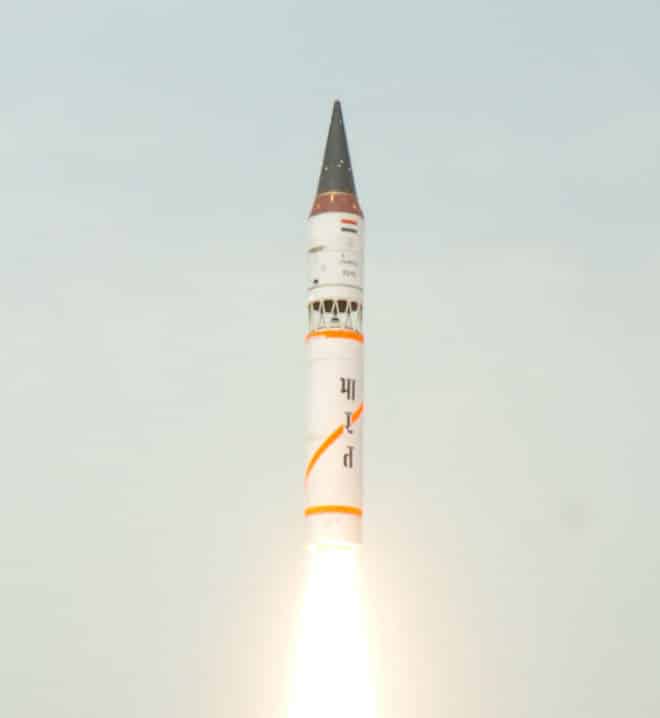The Agni-III is an Indian intermediate-range ballistic missile (IRBM) with a range of 3,000 – 3,500 km. It entered service with India’s Strategic Forces Command in 2011, serving alongside the Agni-II as a nuclear delivery system.1
Agni-III at a Glance
- Originated from
- India
- Class
- Intermediate-range ballistic missile (IRBM)
- Possessed by
- India
- Basing
- Rail-mobile, road-mobile possible
- Length
- 16.7 m
- Diameter
- 2 m
- Launch weight
- 48,300 kg
- Payload
- 1,500 kg
- Warhead
- Nuclear, 200 – 300 kT; possible conventional version
- Propulsion
- Two-stage, solid propellant
- Range
- 3,000 – 3,500 km
- In service
- 2011

Screenshot of first successful Agni-III test, 2007. Photo: India MoD 
Agni-III testing structure. Photo: DRDO 
May 2008 flight test. Photo: DRDO
Agni-III Development
India’s Advanced Systems Laboratory (ASL), a unit of the Defence Research and Development Organisation (DRDO), began developing the Agni-III in the late 1990s. Despite initial plans to test in 2003, the DRDO postponed the missile’s inaugural launch until 2006 due to ongoing diplomatic initiatives.2
On July 9, 2006, the DRDO conducted its first test of the missile from its Integrated Test Range (ITR) facility on Wheeler Island, Odisha. The test was unsuccessful; after launch, the missile prematurely fell into the Bay of Bengal. A post-flight analysis attributed the failure to design flaws in the missile’s thrust vector control system, which improperly sealed its hot motor gases.3
The Agni-III’s second—and first successful—test took place on April 12, 2007; the missile traveled 3,500 km from its launch site in Odisha.4 Following the successful launch, India displayed the Agni-III during its Republic Day Parade on January 26, 2008.
On May 7, 2008, India flight tested the Agni-III for the third time. Launched from the ITR, the missile travelled 3,000 km before landing in the Indian Ocean.5 A fourth flight test, also successful, occurred on February 7, 2010, reaching an apogee of 350 km before landing 3,500 km away in the Indian Ocean. Following the test, the Indian Ministry of Defence declared the missile as ready for induction into service.6
The Indian Army accepted the Agni-III into service in June 2011.7 On September 21, 2012, the Indian Strategic Forces Command successfully flight tested an Agni-III randomly selected from a production lot. The missile reached an apogee of 500 km and range of 3,000 km before impacting in the Indian Ocean.8
SFC conducted a sixth test launch—the fifth successful launch—on December 23, 2013.9 Two additional tests, both successful, took place on April 16, 2015 and April 27, 2017.10 On December 1, 2019, the Indian Army conducted its first nighttime launch of the Agni-III, which failed after separation of its first stage.11
Date Location Result July 9, 2006 ITR Failure; first stage flexseal malfunction April 12, 2007 ITR Success; 3,500 km, first successful flight May 7, 2008 ITR Success; 3,000 km February 7, 2010 ITR Success; 3,000 km, 350 km apogee September 21, 2012 ITR Success; 3,000 km, 500 km apogee; first production missile December 23, 2013 ITR Success April 16, 2015 ITR Success April 26, 2017 ITR Success December 1, 2019 ITR Failure; stage separation malfunction; first night launch
Agni-III Design
The Agni III is 16.7 meters long, 2 meters in diameter, and has a launch weight of 48,300 kg.12 The two-stage, solid-fueled missile can launch a 1,500 kg payload to an estimated range of 3,000 – 3,500 km. Fewer than 10 missiles are believed to be in service.13
The Agni-III’s first-stage motor uses a maraging steel motor case and contains 30,000 kg of propellant, generating up to 106,050 kg of vacuum thrust. The missile’s second stage uses a carbon fiber motor case and contains 12,180 kg of propellant, generating 3,677 kg of thrust. Both stages employ submerged nozzles with a flexseal thrust vectoring system for control.14
The Agni-III employs a strapdown INS/GPS guidance system—and potentially a terminal seeker—to reach an accuracy of 40 m circular error probable (CEP). The missile is primarily employed with a nuclear warhead with an estimated 200 – 300 kT yield. It might also be fitted with conventional unitary and submunition warheads.15 In 2008, the Indian Institute of Science claimed it could increase the missile’s range to 4,900 km with new metallic coatings, which would react with the surrounding airflow to reduce aerodynamic resistance. It is unclear whether such coatings were ever operationalized.16
The SFC presently employs the Agni-III on rail-based launchers, though reports suggest that road-mobile systems may become available in the future.
Footnotes
- James C. O’Halloran, “Agni 1/2/3/4/5,” in IHS Jane’s Weapons: Strategic, (IHS; 2015). 33.
- “Agni-III test-fire this year: Fernandes,” The Hindu, April 7, 2003, https://www.thehindu.com/todays-paper/agni-iii-test-fire-this-year-fernandes/article27755093.ece; T.S. Subramanian, “Agni-III launch in August or September,” The Hindu, June 7, 2006, https://www.thehindu.com/todays-paper/tp-national/agni-iii-launch-in-august-or-september/article18438922.ece.
- Raj Chengappa, “The long ranger,” India today, February 11, 2010, https://www.indiatoday.in/magazine/defence/story/20100222-the-long-ranger-742056-2010-02-11; “Agni III take off successful,” Release 18775, India Press Information Bureau, July 9, 2006, https://archive.pib.gov.in/archive2/AdvSearch.aspx; “Learn from mistakes – Pranab to Defence Scientists,” Release 18821, India Press Information Bureau, July 12, 2006, https://archive.pib.gov.in/archive2/AdvSearch.aspx; “Indian missile test ‘was failure’,” BBC News, July 10, 2006, http://news.bbc.co.uk/2/hi/south_asia/5162416.stm.
- Ibid; “Agni III launched successfully,” Release 26817, India Press Information Bureau, April 12, 2007, https://archive.pib.gov.in/archive2/AdvSearch.aspx; “India tests longest-range missile,” BBC News, April 12, 2007, http://news.bbc.co.uk/2/hi/south_asia/6547449.stm.
- “India tests nuclear-capable Agni III missile,” Reuters, May 7, 2008, https://www.reuters.com/article/idINIndia-33447520080507.
- Chengappa 2010; “India missile ready for army use,” BBC News, February 8, 2010, http://news.bbc.co.uk/2/hi/south_asia/8503455.stm.
- “India conducts 1st night trial of nuclear capable Agni-III missile,” Livemint, December 1, 2019, https://www.livemint.com/news/india/india-conducts-1st-night-trial-of-nuclear-capable-agni-iii-missile-11575169616977.html.
- Y. Mallikarjun, “Agni-III test-fired successfully,” The Hindu, September 21, 2012, https://www.thehindu.com/news/national/agniiii-testfired-successfully/article3922230.ece.
- Jatinder Kaur Tur, “Agni-III test-fired successfully, Times of India, December 23, 2013, https://timesofindia.indiatimes.com/india/agni-iii-test-fired-successfully/articleshow/27810334.cms.
- Y. Mallikarjun, “Agni-III missile test-fired successfully by SFC,” The Hindu, April 16, 2015, https://www.thehindu.com/news/agniiii-missile-testfired-successfully-by-sfc/article7108524.ece;”India successfully test fires nuclear capable Agni-III missile off Odisha coast,” New Indian Express, April 27, 2017, https://www.newindianexpress.com/nation/2017/apr/27/india-successfully-test-fires-nuclear-capable-agni-iii-missile-off-odisha-coast-1598412.html.
- Ankit Panda, “Indian Agni-III Intermediate-Range Ballistic Missile Nighttime Trial Fails,” The Diplomat, December 2, 2019, https://thediplomat.com/2019/12/indian-agni-iii-intermediate-range-ballistic-missile-nighttime-trial-fails/.
- Ibid; T.S. Subramanian, “Perfect mission: Scientific Adviser to Defence Minister,” The Hindu, April 13, 2007, https://www.thehindu.com/todays-paper/Perfect-mission-Scientific-Adviser-to-Defence-Minister/article14748978.ece.
- Ibid; India PIB 2007; Hans M. Kristensen and Robert S. Norris, “Indian nuclear forces, 2012,” Bulletin of the Atomic Scientists Nuclear notebook, Vol. 68 issue 4 (2012) 98; Hans M. Kristensen and Robert S. Norris, “Indian nuclear forces, 2015,” Bulletin of the Atomic Scientists Nuclear notebook, Vol. 71 issue 5 (2015) 80; Defense Intelligence Ballistic Missile Analysis Committee, Ballistic and Cruise Missile Threat 2020, (Wright-Patterson AFB, OH: National Air and Space Intelligence Center, 2020).
- Rajaram Nagappa, Evolution of Solid Propellant Rockets in India (New Delhi: Defence Research and Development Organisation, 2013).
- James C. O’Halloran, “Agni 1/2/3/4/5,” in IHS Jane’s Weapons: Strategic, (IHS; 2015). 34.
- Karthik Subbaraman & Peerzada Abrar, “New tech to boost missile range by 40%,” The Economic Times, September 10, 2008, https://economictimes.indiatimes.com/new-tech-to-boost-missile-range-by-40/articleshow/3464620.cms?from=mdr; “Breakthrough tech to increase range of high speed missiles,” Livemint, October 16, 2008, https://www.livemint.com/Industry/bUEOUiofMuHQXutyrTiFVN/Breakthrough-tech-to-increase-range-of-high-speed-missiles.html.